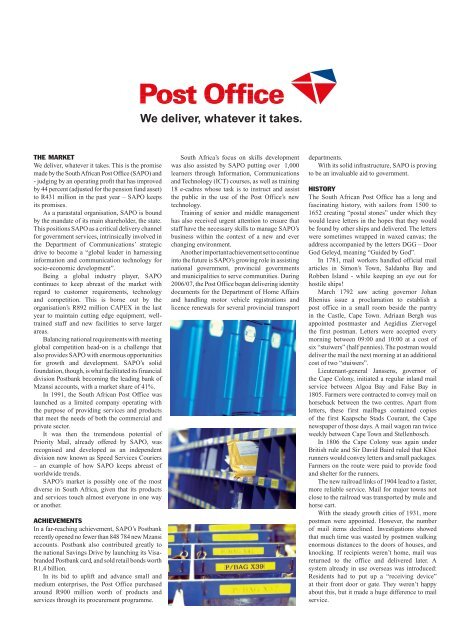South Africa Edition 2
You also want an ePaper? Increase the reach of your titles
YUMPU automatically turns print PDFs into web optimized ePapers that Google loves.
THE MARKET<br />
We deliver, whatever it takes. This is the promise<br />
made by the <strong>South</strong> <strong>Africa</strong>n Post Office (SAPO) and<br />
- judging by an operating profit that has improved<br />
by 44 percent (adjusted for the pension fund asset)<br />
to R431 million in the past year – SAPO keeps<br />
its promises.<br />
As a parastatal organisation, SAPO is bound<br />
by the mandate of its main shareholder, the state.<br />
This positions SAPO as a critical delivery channel<br />
for government services, intrinsically involved in<br />
the Department of Communications’ strategic<br />
drive to become a “global leader in harnessing<br />
information and communication technology for<br />
socio-economic development”.<br />
Being a global industry player, SAPO<br />
continues to keep abreast of the market with<br />
regard to customer requirements, technology<br />
and competition. This is borne out by the<br />
organisation’s R892 million CAPEX in the last<br />
year to maintain cutting edge equipment, welltrained<br />
staff and new facilities to serve larger<br />
areas.<br />
Balancing national requirements with meeting<br />
global competition head-on is a challenge that<br />
also provides SAPO with enormous opportunities<br />
for growth and development. SAPO’s solid<br />
foundation, though, is what facilitated its financial<br />
division Postbank becoming the leading bank of<br />
Mzansi accounts, with a market share of 41%.<br />
In 1991, the <strong>South</strong> <strong>Africa</strong>n Post Office was<br />
launched as a limited company operating with<br />
the purpose of providing services and products<br />
that meet the needs of both the commercial and<br />
private sector.<br />
It was then the tremendous potential of<br />
Priority Mail, already offered by SAPO, was<br />
recognised and developed as an independent<br />
division now known as Speed Services Couriers<br />
– an example of how SAPO keeps abreast of<br />
worldwide trends.<br />
SAPO’s market is possibly one of the most<br />
diverse in <strong>South</strong> <strong>Africa</strong>, given that its products<br />
and services touch almost everyone in one way<br />
or another.<br />
ACHIEVEMENTS<br />
In a far-reaching achievement, SAPO’s Postbank<br />
recently opened no fewer than 848 784 new Mzansi<br />
accounts. Postbank also contributed greatly to<br />
the national Savings Drive by launching its Visabranded<br />
Postbank card, and sold retail bonds worth<br />
R1,4 billion.<br />
In its bid to uplift and advance small and<br />
medium enterprises, the Post Office purchased<br />
around R900 million worth of products and<br />
services through its procurement programme.<br />
<strong>South</strong> <strong>Africa</strong>’s focus on skills development<br />
was also assisted by SAPO putting over 1,000<br />
learners through Information, Communications<br />
and Technology (ICT) courses, as well as training<br />
18 e-cadres whose task is to instruct and assist<br />
the public in the use of the Post Office’s new<br />
technology.<br />
Training of senior and middle management<br />
has also received urgent attention to ensure that<br />
staff have the necessary skills to manage SAPO’s<br />
business within the context of a new and ever<br />
changing environment.<br />
Another important achievement set to continue<br />
into the future is SAPO’s growing role in assisting<br />
national government, provincial governments<br />
and municipalities to serve communities. During<br />
2006/07, the Post Office began delivering identity<br />
documents for the Department of Home Affairs<br />
and handling motor vehicle registrations and<br />
licence renewals for several provincial transport<br />
departments.<br />
With its solid infrastructure, SAPO is proving<br />
to be an invaluable aid to government.<br />
HISTORY<br />
The <strong>South</strong> <strong>Africa</strong>n Post Office has a long and<br />
fascinating history, with sailors from 1500 to<br />
1652 creating “postal stones” under which they<br />
would leave letters in the hopes that they would<br />
be found by other ships and delivered. The letters<br />
were sometimes wrapped in waxed canvas; the<br />
address accompanied by the letters DGG – Door<br />
God Geleyd, meaning “Guided by God”.<br />
In 1781, mail workers handled official mail<br />
articles in Simon’s Town, Saldanha Bay and<br />
Robben Island - while keeping an eye out for<br />
hostile ships!<br />
March 1792 saw acting governor Johan<br />
Rhenius issue a proclamation to establish a<br />
post office in a small room beside the pantry<br />
in the Castle, Cape Town. Adriaan Bergh was<br />
appointed postmaster and Aegidius Ziervogel<br />
the first postman. Letters were accepted every<br />
morning between 09:00 and 10:00 at a cost of<br />
six “stuiwers” (half pennies). The postman would<br />
deliver the mail the next morning at an additional<br />
cost of two “stuiwers”.<br />
Lieutenant-general Janssens, governor of<br />
the Cape Colony, initiated a regular inland mail<br />
service between Algoa Bay and False Bay in<br />
1805. Farmers were contracted to convey mail on<br />
horseback between the two centres. Apart from<br />
letters, these first mailbags contained copies<br />
of the first Kaapsche Stads Courant, the Cape<br />
newspaper of those days. A mail wagon ran twice<br />
weekly between Cape Town and Stellenbosch.<br />
In 1806 the Cape Colony was again under<br />
British rule and Sir David Baird ruled that Khoi<br />
runners would convey letters and small packages.<br />
Farmers on the route were paid to provide food<br />
and shelter for the runners.<br />
The new railroad links of 1904 lead to a faster,<br />
more reliable service. Mail for major towns not<br />
close to the railroad was transported by mule and<br />
horse cart.<br />
With the steady growth cities of 1931, more<br />
postmen were appointed. However, the number<br />
of mail items declined. Investigations showed<br />
that much time was wasted by postmen walking<br />
enormous distances to the doors of houses, and<br />
knocking. If recipients weren’t home, mail was<br />
returned to the office and delivered later. A<br />
system already in use overseas was introduced:<br />
Residents had to put up a “receiving device”<br />
at their front door or gate. They weren’t happy<br />
about this, but it made a huge difference to mail<br />
service.

















